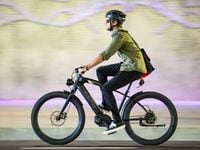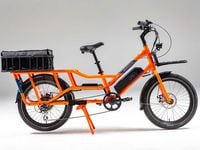It could be any combination of electric motor and traditional human-powered bicycle, but it turns out “eBike” means very specific things in different parts of the world because regulations define when a bicycle turns into a moped or motorcycle—subject to registration, insurance, and motor vehicle codes. Stay under the local regulations for power addition to a bicycle, and your bicycle-plus-electric-motor is just a bicycle, as far as the law is concerned. The difference could save you hundreds of dollars a year in fees and insurance.
In Europe, where eBikes have stormed the bicycle market like Apple did the flip-phone market with the iPhone, 99 percent of the 2.5 million eBikes sold last year were “pedelecs”—pedal-electrics—that complied with European Union eBike rules. The most important of those are a limit of 250 watts rated motor power and an assist system that works by measuring and amplifying pedal effort. There is no motorcycle-like throttle. Instead, a controller senses how hard you are pedaling, and then amplifies that with electric motor power by a factor of two, three, four, or even more.
The experience is literally grin-inducing: You start pedaling what seems like a normal bicycle, and you are suddenly accelerated forward as if you were using Greg LeMond’s legs and not your own. You feel like Superman. I’ve offered many people their first ride on an eBike, and one thing is universally true: They come off the ride grinning. Average cyclists rarely sustain much more than 10 mph on level ground; on an EU-spec eBike, you can do 15 mph all day, including up mild hills, and without working up a sweat on your commute in work clothes. Go faster, though, and you run into the regulations: EU pedelecs are only allowed to provide power assistance up to 25 km/h, which is about 15 mph. After that, your legs are on their own.
The US rules are far more favorable, even as US eBike sales have lagged far behind Europe. The Federal definition of an e-bicycle allows a 750-watt motor (about 1 hp) and allows it to power the bicycle up to 20 mph. The machine can be pedelec or use a throttle. Some state rules are even more favorable. California, whose recently passed laws are serving as models for other states, defines three classes of eBikes. Class 3 California eBikes are allowed to go 28 mph on electric assist, and basically are similar with Swiss and EU rules on a class of machines known as speed-pedelecs (usually shortened to S-Pedelec). Operating a Class 3 eBike in California requires that you be 16 years or older and that you wear a helmet, and you're not supposed to use dedicated bike paths but may use bike lanes on roads. But, again, a Class 3 eBike is just a bicycle as far as the state is concerned, and no registration, licensing, or insurance is required.
As to why you need an eBike, the reasons are manifold, but three are very compelling. First, in most dense urban environments, eBikes have proven to be the fastest ways to get around cities, beating autos, buses, subways, and rail over most distances up to the 4- or 5-mile range. Second, they’re efficient and cheap to operate. A typical eBike achieves somewhere around the 2,000 MPGe on the EPA’s electric vehicle fuel economy rating, about 20 times better than a Tesla and 100 times better than a typical gas-powered auto. A 10-mile round-trip commute takes about 2 cents of electricity at typical prices. And, finally, pedelec-style eBikes still require you to get a little exercise. You can pedal as hard or as meekly as you’d like, but any work you do is exercise you wouldn’t get in a car. All while having fun doing it!

/cloudfront-us-east-1.images.arcpublishing.com/octane/64XSRRNK7FA67IKKYNS64M2LLM.jpg)
/cloudfront-us-east-1.images.arcpublishing.com/octane/BCPI5AVRTRAGJJXFUJFTXKYPNU.jpg)
/cloudfront-us-east-1.images.arcpublishing.com/octane/SLEXAPVAUVHXJEVCOSDQ4X4V2Y.jpg)
/cloudfront-us-east-1.images.arcpublishing.com/octane/7PG4F2A5ENEC7HWN56UXSHG42E.jpg)
/cloudfront-us-east-1.images.arcpublishing.com/octane/QXIFL3IUHFF6XBKWBSOBAEYU6E.jpg)
/cloudfront-us-east-1.images.arcpublishing.com/octane/RRKZHUMAY5GUPNDVRUZTKJZIG4.jpg)
/cloudfront-us-east-1.images.arcpublishing.com/octane/UIKFUXNZBZCSBFG5RAA3JUIWJE.jpg)
/cloudfront-us-east-1.images.arcpublishing.com/octane/EFVNPX2SEFB4RKROYTCAU72MXE.jpg)
/cloudfront-us-east-1.images.arcpublishing.com/octane/3FQ52XVEGVEATIHVFKFJ5IE3WI.jpg)
/cloudfront-us-east-1.images.arcpublishing.com/octane/OMKF3TX7QFBXJJAHJYEM546MNQ.jpg)

/cloudfront-us-east-1.images.arcpublishing.com/octane/GEAFOAZUT5HC5HOVB53DXZ3NKQ.jpg)
/cloudfront-us-east-1.images.arcpublishing.com/octane/KSYPYGAGWVCWBJVTU73BN3XMSA.jpg)
/cloudfront-us-east-1.images.arcpublishing.com/octane/HVGW2KNFSFHK3GZ2VHGXDUKGVM.jpg)
/cloudfront-us-east-1.images.arcpublishing.com/octane/COGMPYKMWJFHNLRB6DPF6P5DHU.jpg)
/cloudfront-us-east-1.images.arcpublishing.com/octane/KQEPQMYNA5A73CCY5NY2QVFRBU.jpg)
/cloudfront-us-east-1.images.arcpublishing.com/octane/XKNKQTC3T5HOPBLELV2VNUDV2I.jpg)
/cloudfront-us-east-1.images.arcpublishing.com/octane/7DPPG4RP3BAA5MGASUXCALC2BA.jpg)
/cloudfront-us-east-1.images.arcpublishing.com/octane/PG3YCWOMDJD2DIMZRKEYKMDK6U.jpg)
/cloudfront-us-east-1.images.arcpublishing.com/octane/6Y2CT4BZAZFIHDXJQXLJJ4SL6A.jpg)
/cloudfront-us-east-1.images.arcpublishing.com/octane/7DIX3PDUL5GULCNQP4SP5SF474.jpg)
/cloudfront-us-east-1.images.arcpublishing.com/octane/XAFIAOLCHFHZZFWUD4DLCOGVQQ.jpg)
/cloudfront-us-east-1.images.arcpublishing.com/octane/O7O55GYQVRDGJPFSUDKNY2ZK24.jpg)
/cloudfront-us-east-1.images.arcpublishing.com/octane/I7GGEJ4RIJCBPDVPXPQLSETLCA.jpg)